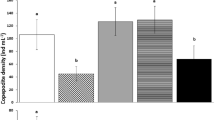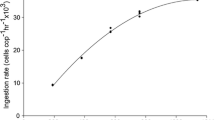Abstract
Understanding and optimising the parameters that controls the success for copepod cultures are the foundation for large scaled copepod cultures. Many underlying copepod culture parameters are already quantified and comprehended, but there is a lack in knowledge of optimising feeding regimes for copepod cultures. In the present study, quantification and observations on how three different feeding regimes affected Acartia tonsa cultures, in terms of development time, specific growth rate, egg production, and egg hatching success were done. The three feeding regimes where dispensed as; once a day (spiked feeding), in four equal pulses (pulsed feeding), and evenly over 24 h (continuous feeding). The feeding regimes were investigated at low food levels (~200 µg C L−1) and at full-saturated food levels (~1800 µg C L−1). As photoperiod may have an effect on feeding uptake and productivity, the present experiments were segregated into two light regimes, one in darkness (0L:24D) and one in light (24L:0D). Acartia tonsa exposed to fully saturate feed levels developed twice as fast as at low saturated feed levels. A significantly higher total egg production from copepods was observed, equal to 53.5 % more eggs produced in dark cultures. Also, a 2.3 % significantly higher egg hatching success was obtained when culturing in dark. Since feeding regimes do not affect cultures, it is recommended that feeding of A. tonsa should be conducted as practical as possible for the individual copepod farmer, since optimal performance will be met as long as feed is supplied in excess. Furthermore, it is recommended that cultures are kept in dark for optimal egg production and sub sequent hatching success.






Similar content being viewed by others
References
Baensch FU, Tamaru CS (2009) Captive hybridization of two geographically isolated pygmy angelfish species, Centropyge fisheri and Centropyge resplendens. J Fish Biol 75:2571–2584
Berggreen U, Hansen B et al (1988) food size spectra, ingestion and growth of the copepod Acartia tonsa during development—implications for determination of copepod production. Mar Biol 99(3):341–352
Brown JA, Wiseman D et al (1997) The use of behavioural observations in the larviculture of cold-water marine fish. Aquaculture 155(1–4):297–306
Buttino I (1994) The effect of low concentrations of phenol and ammonia on egg-production rates, fecal pellet production and egg viability of the calanoid copepod Acartia clausi. Mar Biol 119:629–634
Buttino I, Ianora A et al (2012) Experimental cultivation of the mediterranean calanoid copepods Temora stylifera and Centropages typicus in a pilot re-circulating system. Aquac Res 43:247–259
Calbet Albert et al (1999) Short communication. Food availability and diel feeding rhythms in the marine copepods Acartia grani and Centropages typicus. J Plankton Res 21(5):1009–1015
Calliari D, Andersen C et al (2006) Salinity modulates the energy balance and reproductive success of co-occurring copepods Acartia tonsa and A. clausi in different ways. Mar Ecol Prog Ser 312:177–188
Carotenuto Y, Esposito F et al (2012) Multi-generation cultivation of the copepod Calanus helgolandicus in a re-circulating system. J Exp Mar Biol Ecol 418–419:46–58
Dagg M (1977) Some effects of patchy food environments on copepods. Limnol Oceanogr 22:99–107
Drillet G, Iversen MH et al (2006a) Effect of cold storage upon eggs of a calanoid copepod, Acartia tonsa (Dana) and their offspring. Aquaculture 254(1–4):714–729
Drillet G, Jørgensen NOG et al (2006b) Biochemical and technical observations supporting the use of copepods as live feed organisms in marine larviculture. Aquac Res 37(8):756–772
Drillet G, Goetze E et al (2008a) Strain-specific vital rates in four Acartia tonsa cultures, I: strain origin, genetic differentiation and egg survivorship. Aquaculture 280(1–4):109–116
Drillet G, Jepsen PM et al (2008b) Strain-specific vital rates in four Acartia tonsa cultures II: life history traits and biochemical contents of eggs and adults. Aquaculture 279(1–4):47–54
Drillet G, Frouel S et al (2011) Status and recommendations on marine copepod cultivation for use as live feed. Aquaculture 315(3–4):155–166
Drillet G, Rais M et al (2014) Total egg harvest by the calanoid copepod Acartia tonsa (Dana) in intensive culture—effects of high stocking densities and water quality on daily egg production and egg quality. Aquaculture Research. doi:10.1111/are.12459
Durbin EG, Durbin AG, Smayda TJ, Verity PG (1983) Food limitation of production of production by adult Acartia tonsa in Narragansett Bay, Rhode Island. Limnol Ocenanogr 28:1199–1213
Frost BW (1972) Effects of size and concentration of food particles on the feeding behavior of the marine planktonic copepod Calanus pacificus. Limnol Ocenanogr 17(6):805–815
Hagemann A, Øie G et al (2016) Effects of light and short-term temperature elevation on the 48-h hatching success of cold-stored Acartia tonsa Dana eggs. Aquacult Int 24(1):57–68
Hansen PJ (1989) The red tide dinoflagellate Alexandrium tamarense - effects on behavior and growth of a Tintinnid ciliate. Mar Ecol Prog Ser 53(2):105–116
Hansen BW, Drillet G et al (2010) Temperature effects on copepod egg hatching: Does acclimatization matter? J Plankton Res 32(3):305–315
Hansen BW, Drillet G et al (2012) Do Acartia tonsa (Dana) eggs regulate their volume and osmolality as salinity changes? J Comp Physiol B 182(5):613–623
Hansen BW, Buttino I et al (2016) Embryonic cold storage capability from seven strains of Acartia spp. isolated in different geographical areas. Aquaculture 457:131–139
Hurlbert SH (1984) Psedoreplication and the design of ecological field experiments. Ecol Monogr 54:187–211
Jensen KR (2010) NOBANIS—Invasive Alien Species Fact Sheet—Acartia tonsa—From: Identification key to marine invasive species in Nordic waters—NOBANIS www.nobanis.org. Date of access 18 Sep 2013
Jepsen PM, Andersen A et al (2007) Effects of adult stocking density on egg production and viability in cultures of the calanoid copepod Acartia tonsa (Dana). Aquac Res 38:764–772
Jepsen PM, Andersen CVB, Schjelde J, Hansen BW (2015) Tolerance of un-ionized ammonia in live feed cultures of the calanoid copepod Acartia tonsa Dana. Aquac Res 46:420–431
Jónasdóttir SH (1994) Effects of food quality on the reproductive success of Acartia tonsa and Acartia hudsonica: laboratory observations. Mar Biol 121(1):67–81
Kiørboe T, Møhlenberg F et al (1985) In situ feeding rates of planktonic copepods: a comparison of 4 methods. J Exp Mar Biol Ecol 88(1):67–81
Klein Breteler WCM, Koski M et al (2004) Role of essential lipids in copepod nutrition: no evidence for trophic upgrading of food quality by a marine ciliate. Mar Ecol Prog Ser 274:199–208
Marcus NH, Murray M (2001) Copepod diapause eggs: a potential source of nauplii for aquaculture. Aquaculture 201:107–115
Marcus NH, Richmond C et al (2004) Impact of hypoxia on the survival, egg production and population dynamics of Acartia tonsa Dana. J Exp Mar Biol Ecol 301:111–128
Mauchline J (1998) The Biology of Calanoid Copepods, vol 710. Elsevier Academic Press, Oxford 0-12-105445-0
Nilsson B, Jepsen PM et al (2014) Expression of hsp70 and ferritin in embryos of the copepod Acartia tonsa (Dana) during transition between subitaneous and quiescent state. J Plankton Res 36(2):513–522
Øie G, Galloway T. et al. (2015) Effect of cultivated copepods (Acartia tonsa) in first-feeding of Atlantic cod (Gadus morhua) and ballan wrasse (Labrus bergylta) larvae. Aquac Nutr. doi:10.1111/anu.12352
Olivotto I, Chemello G, Vargas A, Randazzo B, Piccinetti CC, Carnevali O (2016). “Marine ornamental species culture: From the past to “Finding Dory”. Gen comp endocrinol (available online)
Payne MF, Rippingale RJ (2001) Intensive cultivation of the calanoid copepod Gladioferens imparipes. Aquaculture 201:32–342
Payne MF, Rippingale RJ et al (2001) Cultured copepods as food for West Australian dhufish (Glaucosoma hebraicum) and pink snapper (Pagrus auratus) larvae. Aquaculture 194:137–150
Peck MA, Holste L (2006) Effects of salinity, photoperiod and adult stocking density on egg production and egg hatching success in Acartia tonsa (Calanoida: Copepoda): Optimizing intensive. Aquaculture 255(1–4):341–350
Peck N, Peter J et al (2015) Interactive effects of temperature and salinity on population dynamics of the calanoid copepod Acartia tonsa. J Plankton Res 37(1):197–210
Rabe J, Brown JA (2000) A pulse feeding strategy for rearing larval fish: an experiment with yellowtail flounder. Aquaculture 191(4):289–302
Schipp GR (2006) The Use of Calanoid Copepods in Semi-Intensive, Tropical Marine Fish Larviculture. In: Cruz Suárez LE, Marie DR, Salazar MT, López MGN, Cavazos DAV, Cruz ACP, Ortega AG. Avances en Nutrición VIII. VIII Simposium Internacional de Nutrición Acuícola. 15–17 Noviembre Universidad Autónoma de Nuevo León, Monterrey, Nuevo León, México. ISBN 970-694-333-5
Schipp GR, Bosmans JMP, Marshall AJ (1999) A method for hatchery culture oftropical calanoid copepods, Acartia spp. Aquaculture 174:81–88
Shayegan, Majid, et al. (2016).”Effects of salinity on egg and fecal pellet production, development and survival, adult sex ratio and total life span in the calanoid copepod, Acartia tonsa: a laboratory study.” Chinese J Oceanol Limnol: 1-10
Shields RJ, Bell JG et al (1999) Natural copepods are superior to enriched Artemia nauplii as feed for halibut larvae (Hippoglossus hippoglossus) in terms of survival, pigmentation and retinal morphology: relation to dietary essential fatty acids. J Nutr 129(6):1186–1194
Stearns DE (1986) Copepod grazing behavior in simulated natural light and its relation to nocturnal feeding. Mar Ecol Prog Ser 30:65–76
Stearns DE, Tester PA, Walker RL (1989) Diel changes in the egg production rate of Acartia tonsa (Copepoda, Calanoida) and related environmental factors in two estuaries. Mar Ecol Prog Ser 52:7–16
Støttrup JG (2003) Production and nutritional value of copepods. In: Støttrup JG, McEvoy LA (eds) Live feeds in marine aquaculture. Blackwell Science, Oxford, Malden, p 318
Støttrup JG, Richardson K, Kirkegaard E, Pihl NJ (1986) The cultivation of Acartia tonsa Dana for use as a live food source for marine fish larvae. Aquaculture 52:87–96
Tester PA, Turner JT (1990) “How long does it take copepods to make eggs? J Exp Mar Biol Ecol 141:169–182
Tietjen ABS (2013) Linking environmental factors and the reproductive success of Acartia tonsa DANA (Copepoda: Calanoida). Ph.D. thesis Universität Hamburg:0–216
Tiselius P, Hansen B et al (1995) Can we use laboratory-reared copepods for experiments? A comparison of feeding behaviour and reproduction between a field and a laboratory population of Acartia tonsa. ICES J Mar Sci 52:369–376
Vu MTT, Jepsen PM et al (2014) A comprehensive and precise quantification of the calanoid copepod Acartia tonsa (Dana) for intensive live feed cultures using an automated ZooImage system. Aquaculture 422–423:225–231
Wilcox JA, Tracy PL et al (2006) Improving live feeds: effect of a mixed diet of copepod nauplii (Acartia tonsa) and rotifers on the survival and growth of first-feeding larvae of the southern flounder, Paralichthys lethostigma. J World Aquac Soc 37(1):113–120
Zhang J, Wu C et al (2013) Effects of different monoalgal diets on egg production, hatching success and apoptosis induction in a Mediterranean population of the calanoid copepod Acartia tonsa (Dana). Aquaculture 400–401:65–72
Acknowledgments
This work was funded by IMPAQ Grant (J. No. 10-093522) to Professor Benni W. Hansen and Grant (J. No. 11-116388) to Dr. Per M. Jepsen. Dr. Kim Larsen. Technicians Anne B. Faarborg and Rikke Guttesen are acknowledged for their assistance in the laboratory.
Author information
Authors and Affiliations
Corresponding author
Rights and permissions
About this article
Cite this article
Jepsen, P.M., Bjørbæk, N.S., Rayner, T.A. et al. Recommended feeding regime and light climate in live feed cultures of the calanoid copepod Acartia tonsa Dana. Aquacult Int 25, 635–654 (2017). https://doi.org/10.1007/s10499-016-0063-4
Received:
Accepted:
Published:
Issue Date:
DOI: https://doi.org/10.1007/s10499-016-0063-4




